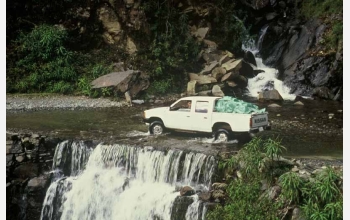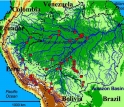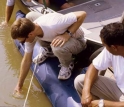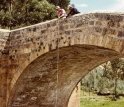News Release 05-126
Amazon River Cycles Carbon Faster than Thought
Carbon is Returned to Atmosphere in Five Short Years

Researchers doing field work in the Amazon River Basin often travel one-lane dirt roads.
July 27, 2005
This material is available primarily for archival purposes. Telephone numbers or other contact information may be out of date; please see current contact information at media contacts.
The rivers of South America's Amazon basin are "breathing" far harder - and cycling the greenhouse gas carbon dioxide far faster - than anyone realized.
Most of the carbon being exhaled as carbon dioxide from Amazonian rivers and wetlands has spent a mere five years sequestered in the trees, plants and soils of the surrounding landscape, researchers report in the July 28 issue of the journal Nature.
Because this time scale is so much shorter than researchers had thought, says James Morris, program director in the National Science Foundation (NSF)'s division of environmental biology, "this work adds important information to the global carbon cycle puzzle."
Morris' division funded the research in conjunction with NSF's Office of International Science and Engineering, the Center for Accelerator Mass Spectrometry at Lawrence Livermore National Laboratory, the National Aeronautics and Space Administration (NASA) and the Research Support Foundation for the State of San Paulo (FAPESP), Brazil.
Until now, explains Emilio Mayorga, University of Washington (UW) oceanographer and lead author of the Nature piece, researchers had hoped that regions such as the nearly 2.4 million-square-mile Amazon River basin, where tropical forests rapidly gulp carbon dioxide during photosynthesis, were holding onto that carbon for decades or centuries.
Indeed, says his co-author, Anthony Aufdenkampe of the Stroud Water Research Center in Pennsylvania, "those who've previously made measurements assumed that the return of this carbon to the atmosphere must be a slow process that offered at least temporary respite from greenhouse effects."
But the data told a different story, Aufdenkampe says: "As part of the largest radiocarbon age survey ever for a single watershed, we show that the enormous amount of carbon dioxide silently being returned to the atmosphere is far 'younger' than carbon being carried downstream."
"'River breath' is clearly happening much faster than anyone realized," says Jeff Richey, an oceanographer at UW and another co-author of the paper.
Carbon is carried by rains and groundwater into waterways from soils, decomposing woody debris, leaf litter and other organic matter. Once in waterways it is chewed up by microorganisms, insects and fish. The carbon dioxide they generate quickly returns to the atmosphere an amount equal to what is absorbed each year by the Amazonian rainforest.
"Land use patterns, vegetation distribution and other parameters in the region are all changing as a result of human activities, and the system is responding fairly quickly," Mayorga says. "Both human and natural systems, in turn, will be impacted."
Other co-authors of the paper are Paul Quay and the late John Hedges, both UW oceanographers; Caroline Masiello of Rice University; Alex Krusche of the University of São Paulo, Brazil; and Thomas Brown of the Center for Accelerator Mass Spectrometry at Lawrence Livermore National Laboratory.
-NSF-
-
Map of Amazon river sampling site.
Credit and Larger Version -
Anthony Aufdenkampe taking water samples from the Pixiam River in Brazil.
Credit and Larger Version -
Accurate sampling requires water from the middle of rivers.
Credit and Larger Version
Media Contacts
Cheryl Dybas, NSF, (703) 292-7734, email: cdybas@nsf.gov
Sandra Hines, UW, (206) 543-2580, email: shines@u.washington.edu
The U.S. National Science Foundation propels the nation forward by advancing fundamental research in all fields of science and engineering. NSF supports research and people by providing facilities, instruments and funding to support their ingenuity and sustain the U.S. as a global leader in research and innovation. With a fiscal year 2023 budget of $9.5 billion, NSF funds reach all 50 states through grants to nearly 2,000 colleges, universities and institutions. Each year, NSF receives more than 40,000 competitive proposals and makes about 11,000 new awards. Those awards include support for cooperative research with industry, Arctic and Antarctic research and operations, and U.S. participation in international scientific efforts.
Connect with us online
NSF website: nsf.gov
NSF News: nsf.gov/news
For News Media: nsf.gov/news/newsroom
Statistics: nsf.gov/statistics/
Awards database: nsf.gov/awardsearch/
Follow us on social
Twitter: twitter.com/NSF
Facebook: facebook.com/US.NSF
Instagram: instagram.com/nsfgov



